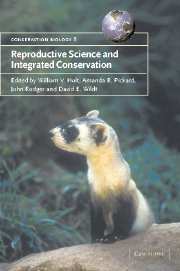Book contents
Part IV - Integrated conservation management
Published online by Cambridge University Press: 21 January 2010
Summary
Science has to be understood in its broadest sense, as amethod for comprehending all observable reality, and not merely as an instrument for acquiring specialised knowledge.
Alexis CarrelAs societies become more conscious of needs for biodiversity conservation, a host of conflicting interests emerge. Investment in wild species preservation may not enjoy high priority in poverty-stricken countries where governments are more concerned with human welfare. Ironically, the poorest countries are often those with the richest biodiversity, a disadvantage that can be turned to advantage when the value of wildlife is transformed into significant tourism revenues. Some countries also may have traditions which do not sit easily alongside wildlife protection; hunting is popular in many societies, even those where some measures of wildlife protection are being introduced. In many cases, wildlife protection comes into conflict with agricultural practices; it certainly is understandable that Nepalese farmers are distraught when a rhinoceros leaves a nearby national park and tramples their crops! Predatory species, especially those regarded as aliens, such as European foxes in Australia, also present a major threat to people, their livelihoods and the success of wildlife reintroduction programmes. Introducing alien species in a foreign environment can wreak havoc, brushtailed possums introduced into New Zealand being a classic example.
Developing cost-effective practical solutions to these massive problems is akin to squaring the circle. Some situations require nurturing and expanding populations while other, so-called nuisance species must be controlled, preferably by humane approaches.
- Type
- Chapter
- Information
- Reproductive Science and Integrated Conservation , pp. 209 - 210Publisher: Cambridge University PressPrint publication year: 2002
- 1
- Cited by

